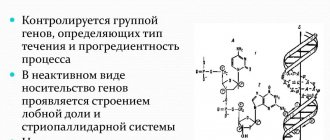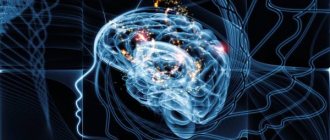Description of the disease
Pathology is diagnosed in young people
The hebephrenic form of schizophrenia is characterized by childish behavior, regardless of the patient’s age. As a rule, people with this diagnosis have a low IQ and are very sensitive to stress, which causes the rapid progression of the disease.
The disease manifests itself at the age of 15-20 years, there are cases of later onset of symptoms in people in the age range from 25 to 30 years, but such cases are rare.
Main features of the disease:
- rapid development of symptoms;
- chronic course;
- rapid destruction of personality.
Today, this pathology is one of the most complex types of schizophrenia, which is extremely difficult to treat. It is impossible to completely get rid of the pathology; it is only possible to reduce the severity of symptoms.
The onset of the disease is characterized by problematic behavior - asociality, increased sexual activity, and criminal tendencies. Considering the fact that the disease first makes itself felt in adolescence, quite often the initial symptoms are not paid attention to, associating them with the characteristics of the puberty period.
In ICD-10, this form of the disease is classified as a separate disease, designated by code F20.1.
Early manifestations of hebephrenia in a child
At school age, children with hebephrenia may be characterized by increased vulnerability and resentment. Such symptoms do not affect academic performance; a child, even in a depressed mental state, can study well. However, closer to adolescence, the teenager becomes rude, disinhibited, and conflictual. Such children have a tendency to alcoholism or drug addiction, friendship with antisocial people, gluttony, and vagrancy.
Subsequently, the patient withdraws into himself and complains of “a feeling of emptiness in the head” or other strange symptoms. At this time, teachers pay attention to his poor performance, inappropriate behavior and absent-mindedness:
- forgets things (textbooks) at school;
- spontaneously leaves class during a lesson or leaves school altogether;
- shows unmotivated aggression towards peers or teachers;
- may loudly shout obscenities at adults for no reason or unreasonably accuse them of anything;
- behaves inappropriately: runs around the class during class, grimaces, disrupts classes;
- becomes sloppy.
Such behavior in a teenager is a reason to consult a psychiatrist. Typically, during an appointment, patients answer simple questions, understand where they are, and are able to name the current date. However, when interviewing a doctor, they act mannered, behave inappropriately, may laugh in response to comments, and are constantly distracted.
History of the study of the disease
The history of the disease, today known as hebephrenic schizophrenia, dates back a century and a half. Hebephrenic schizophrenia was first described in the mid-19th century. This is explained by the development of psychiatry as a science, although the disease was known earlier, but was considered as dementia. In the 19th century, the disease was described as a separate disorder, today called hebephrenic syndrome or hebephrenia. A few years later, the disease began to be classified as schizophrenia.
At first, the disease was called dementia praecox and in 1898 it was classified as a separate subtype of schizophrenic disorder, along with catatonic and paranoid schizophrenia.
Interesting! The disease got its name in honor of Hebe, the goddess of youth.
It is necessary to distinguish between hebephrenic syndrome and hebephrenic schizophrenia. The syndrome can be observed in various diseases, including epilepsy, while hebephrenic schizophrenia or hebephrenia is an independent mental disorder with complex symptoms and rapid progression.
In modern psychiatry, the pathology is often called schizophrenia of the disorganized type.
What is hebephrenic schizophrenia
Despite the fact that patients with this type of schizophrenia can be quite cheerful and sociable, it immediately becomes clear how dangerous they are. These inadequate patients are completely uncontrollable and try to attract the attention of others by any means. The impression of deliberate behavior is created; one might think that the person is simply fooling around or pretending. However, people suffering from hebephrenic schizophrenia are actually seriously ill.
The disease begins in adolescence. The age of the patients corresponds to 15–25 years. Moreover, a continuous course of hebephrenia, without remissions, is more typical.
Hebephrenic schizophrenia is classified as a severe form of mental disorder. The person's condition deteriorates sharply. Irreversible personality defects begin to form. Due to the fact that he loses the ability to adequately assess his strength, in the excitement of the game he can cause pain to others. Uncontrollable behavior is corrected with sedatives.
The main causes of the disease
Mental trauma at an early age can become a catalyst for the manifestation of illness in the future
Pathology refers to endogenous forms of the disease, that is, it is caused either by genetic disorders or perinatal causes.
As with other types of schizophrenia, the main cause is thought to be a gene mutation. The disease can also be inherited, from mother to daughter, or from father to son, but rather an increased risk of developing this disease is transmitted; the entire chain of pathological genes is rarely completely inherited.
According to another version, the cause of the hebephrenic form of schizophrenia is intrauterine infections and fetal hypoxia. Some experts associate the development of this disease with abnormalities in the development of the nervous system.
In general, all these reasons cause a high risk of the disease, but do not predetermine its development. Hebephrenic schizophrenia develops under the influence of one or more of the following triggers:
- unfavorable atmosphere in the family;
- frequent stress and severe emotional experiences;
- traumatic situations in childhood;
- past brain diseases;
- drug use;
- alcohol intoxication.
Education and living conditions in childhood play an important role in the development of the disease. The risk of pathology increases if the child grew up in conditions of constant stress due to pressure from parents, experienced need and was bullied by peers.
A strong trigger is drug addiction and alcoholism. Taking into account the characteristics of hebephrenic schizophrenia, these triggers play an important role, since it is adolescents who often encounter pathological addictions, and the disease also first manifests itself in adolescence.
Symptoms and signs of the disorder
Hebephrenic schizophrenia has a characteristic onset and symptoms in general. In the premorbid period, that is, before the development of pathology, patients usually have a shy character and congenital isolation. Their shy structure often becomes the root cause of loneliness. This form of schizophrenia manifests itself at a fairly early age; its latest manifestation is puberty. The earlier the onset, the more pronounced the personality defect. Naturally, in direct proportion to the defect there will be a defect in social life. This is a pathology that has a poor prognosis, it is continuous in its course and the increase in the clinical picture is quite rapid and massive.
The main manifestation of hebephrenic schizophrenia is foolishness, hence the origin of the name. But these individuals can pose a considerable danger to society, given their uncontrollability. The mood of patients is inappropriately elevated, but this differs from states of mania, since the person suffers from thinking disorders that are completely uncharacteristic of manic states. Behavior is very mannered and pretentious - this is the hallmark of hebephrenic schizophrenia. Often there can be brutality in the structure, especially when the individual is unable to achieve his goals.
Hebephrenic schizophrenia has a special relationship with delusions and hallucinations; these ideas should not be prevalent and generally have an intermittent, broken character. If such productive symptoms prevail, it is worth suspecting another subtype of schizophrenic pathology.
Quite colossal changes in mood affect are also observed in this mental disorder, especially before the formation of a defect, which is absolutely not typical for other types of this pathology.
The described form of schizophrenia often has in its structure the affects of angry excitement, which end in a surge of impulsive aggressive actions. Hypochondriacal complaints may be expressed, which naturally do not have an objective somatic component. These complaints migrate from different organs and often do not have a characteristic symptomatic picture. They often sound ridiculous, and the characteristics of the complaints do not fit the pathology of the organs in question.
You might think that the individual is simply infantile, but this is not the only manifestation of the disease that can lead to such a serious pathology as hebephrenic schizophrenia. Behavior is not just infantile, it has absurdities and obscenities in its structure, as well as hypersexuality and sexual perversions, that is, inadequate forms of manifestation. Serious and collected are completely opposite manifestations, uncharacteristic for these patients.
The strength of the affect is superficial, that is, it does not have deep manifestations, in addition, the patient is inadequate. Characterized by ridiculous giggles, out-of-place merriment, and unreasonable smiles. Mannerism manifests itself in the absurdity and royalty of manners. Playfulness in behavior is very characteristic. Superficial religious hobbies, admiration for rare theoretical sciences and philosophy may appear.
This pathology very quickly develops a schizophrenic defect and specific stupidity. Negative symptoms occupy a dominant role, and defects become flattened with emotional dullness. Symptoms change, behavior becomes aimless and loses all meaning.
Predisposition and prevalence
The disease is a rare form of schizophrenia and is diagnosed in approximately 5% of patients. The pathology first appears in adolescence, and does not depend on gender; both women and men are equally often affected.
The main feature of patients with this diagnosis is a particularly acute reaction to stress factors, so the disease manifests itself much more often in residents of large cities than in small provincial towns and rural areas with their measured pace of life.
All patients with this diagnosis have similar features. Among them:
- underweight in childhood and adolescence;
- below average IQ;
- acute reaction to stress;
- asociality;
- exemplary behavior;
- shyness;
- diffidence;
- lack of initiative.
In childhood, such people are usually very attached to their parents and need their approval. Children demonstrate rather modest mental abilities, avoid intellectual activities, and are very shy.
Course of the disease: from initial symptoms to severe manifestations
Young people suffering from the disorder are “slow” to think and are not very mentally developed
As patients grow older, their behavior changes. As a rule, rebellion, immoral behavior, and a tendency toward aggression manifest themselves in adolescence. Teenagers become overly sexually preoccupied, possibly early onset of sexual activity, and a tendency to use illegal substances and alcohol.
It is this behavior that becomes the first sign of a developing disease, but it is often not paid attention to, since all adolescents are characterized by disobedience and a thirst for new sensations.
Hebephrenic schizophrenia in children can develop against the background of epilepsy. In all other cases, the disease manifests itself after 16 years.
The main manifestation of the initial stage of the disease is excessive foolishness. The teenager behaves and grimaces, does not take anything seriously, actions and way of thinking often look illogical and ridiculous.
As a rule, a schizophrenic defect develops on average over 3-4 years. So, if the initial symptoms began to appear at the age of 16, the disease becomes severe by the age of 19-20. If there are many stressful situations in the patient's life, symptoms may increase more quickly.
Symptoms and signs of hebephrenic schizophrenia:
- delusional ideas;
- anxiety disorder;
- hallucinations;
- stubbornness;
- social alienation;
- slow thinking;
- speech changes;
- inappropriate behavior.
All these symptoms increase gradually. At first, 1-2 signs may be observed, but over time the clinical picture worsens. All this leads to social alienation, isolation, and a tendency to loneliness.
Help for hebephrenic schizophrenia
First aid is an examination by a doctor and establishment of an accurate diagnosis. The specificity of hebephrenic schizophrenia, like other schizophrenic diseases, determines the lack of a critical attitude towards one’s condition.
Patients often do not understand that “I am sick.” In addition, sometimes even they resist attempts by relatives to bring them to a psychiatrist for examination.
If you are faced with an acute manifestation of the disease - the sick person is agitated, does not respond to you, screams, makes ridiculous faces and shows aggression - you should immediately call an ambulance or an intervention team.
As a rule, in case of severe behavioral disturbances and potential danger to oneself or others, hospitalization is used; if the patient refuses, involuntary hospitalization is used.
If there is no overexcitation, but the patient stubbornly refuses to be examined by a doctor, visit a psychiatrist yourself (without the patient). At the consultation, the doctor, in your words, will assess the situation and tell you what to do correctly to start treatment.
Key features of the disease
The illness is accompanied by severe hysterics
In hebephrenia or hebephrenic schizophrenia, symptoms begin to increase with changes in behavior. A key feature of the disease is childish, goofy behavior. The patient grimaces, copies the facial expressions of other people, clowns around and plays the fool. All this looks illogical and inconsistent, while the patient ignores the comments of strangers.
With hebephrenia, there is precisely a deliberate or feigned “childishness”; sometimes the patient’s behavior from the outside resembles an attempt by an adult to imitate a child. Unnatural behavior manifests itself:
- stupid giggle;
- voice change;
- causeless fun;
- unnatural facial expressions;
- hysterical;
- mood swings.
Patients with this diagnosis are very stubborn and can throw a tantrum if they don’t get what they want. They often demonstrate a penchant for silly rhymes and childish “teasing.” Behavior is illogical, actions are not motivated by anything. Thinking slows down, reasoning is very superficial, speech is often incoherent.
In particularly severe cases, more severe symptoms are also present:
- delusions and hallucinations;
- catatonic syndrome;
- hypochondria;
- manic syndrome.
At the same time, a person loses touch with reality and often cannot identify himself. Over time, speech becomes scarcer, vocabulary decreases, and a tendency toward stupor and numbness appears.
Causes
Hebephrenia has no clearly defined causes. The factors that provoke its development are still poorly understood. Most scientists believe that the main cause of the disorder is unfavorable heredity. If one of the parents has a mild form of hebephrenic schizophrenia, the likelihood that it will manifest itself in the child is considered high. A mild form of hebephrenia occurs almost unnoticed, with the exception of frequent mood swings. Most school-age patients can study in regular educational institutions.
Diagnosis of the disease
The diagnosis is made based on observation of the patient's behavior. To diagnose this form of the disease, it is necessary to have the main specific symptom of hebephrenia – foolishness. Secondary symptoms such as flattened affect, impoverished speech, and intermittent thinking are also taken into account.
Differential diagnosis is carried out with epilepsy, malignant diseases and infectious lesions of the brain. When making a diagnosis, it is necessary to exclude Pick's disease and Huntington's chorea.
In general, for an accurate diagnosis, specific symptoms of hebephrenia must be present for two weeks or more.
Symptoms
Hebephrenic schizophrenia has a large number of external specific signs, which allows an accurate diagnosis to be made.
First clinical manifestations:
- isolation;
- sleep disorder;
- increased appetite;
- detachment from loved ones;
- a noticeable decrease in intellectual abilities;
- increasing weakness.
Main symptoms:
- pretentious and silly behavior is the most distinctive manifestation when, regardless of age category, a person behaves like a child;
- grimacing and moodiness;
- frequent mood swings;
- disorganization of thinking and speech;
- lack of logic in spoken phrases;
- intermittent speech and poor vocabulary;
- frequent repetition of the same movements or expressions;
- a gross form of infantilism;
- absolute lack of motivation for actions;
- brutality of actions;
- inability to predict words or actions, evaluate them from the point of view of common sense;
- causeless laughter or tears;
- increased sexual activity;
- sloppiness at the table against the backdrop of a good appetite;
- indifference and indifference to everything that happens;
- lack of plans for the future or manifestations of empathy for others;
- unfounded health complaints;
- tendency not to show interest in one's appearance and personal hygiene;
- empty euphoria;
- public display of genitals and masturbation, which is often accompanied by swearing, ridiculous language and insults - typical for sick children;
- abuse of bad habits - observed even in childhood;
- clownism and feigned prank;
- dementia and inability to concentrate;
- the presence of diminutive words in the lexicon;
- hallucinations and delusions - in some patients may be present on a constant basis, while in others - only occasionally; hallucinations may be of a religious, sexual or hypochondriacal nature.
Almost always, hebephrenia is expressed in a continuous course. In rare situations, a paroxysmal form is observed, when rare and short periods of remission are observed. The paroxysmal type of the disease gradually turns into a malignant form of schizophrenia with each subsequent exacerbation. The patient becomes socially dangerous within 2 years.
Signs of hebephrenia in adults
Treatment principle
Tablets are taken regardless of meals
Large doses of antipsychotics and tranquilizers are used to treat hebephrenic schizophrenia.
The main problem with drug therapy for this disease is the patient’s body’s resistance to the effects of the drugs. If immunity develops too quickly, electroconvulsive and insulin shock therapy may be additionally indicated.
The choice of antipsychotics and tranquilizers depends on the characteristics of the course of the disease. Antipsychotics reduce delusions and hallucinations; the drugs of choice are Haloperidol, Chlorpromazine, Clozapine. Tranquilizers are administered intravenously for manic and catatonic syndrome.
Treatment is carried out in a hospital setting. After discharge, the patient is prescribed maintenance therapy to reduce the risk of relapse.
Psychotherapy
In hebephrenic schizophrenia, psychotherapy is prescribed only when remission is achieved due to drug correction. Individual and group psychotherapy is practiced, aimed at improving the speed of thinking and socialization of the patient.











